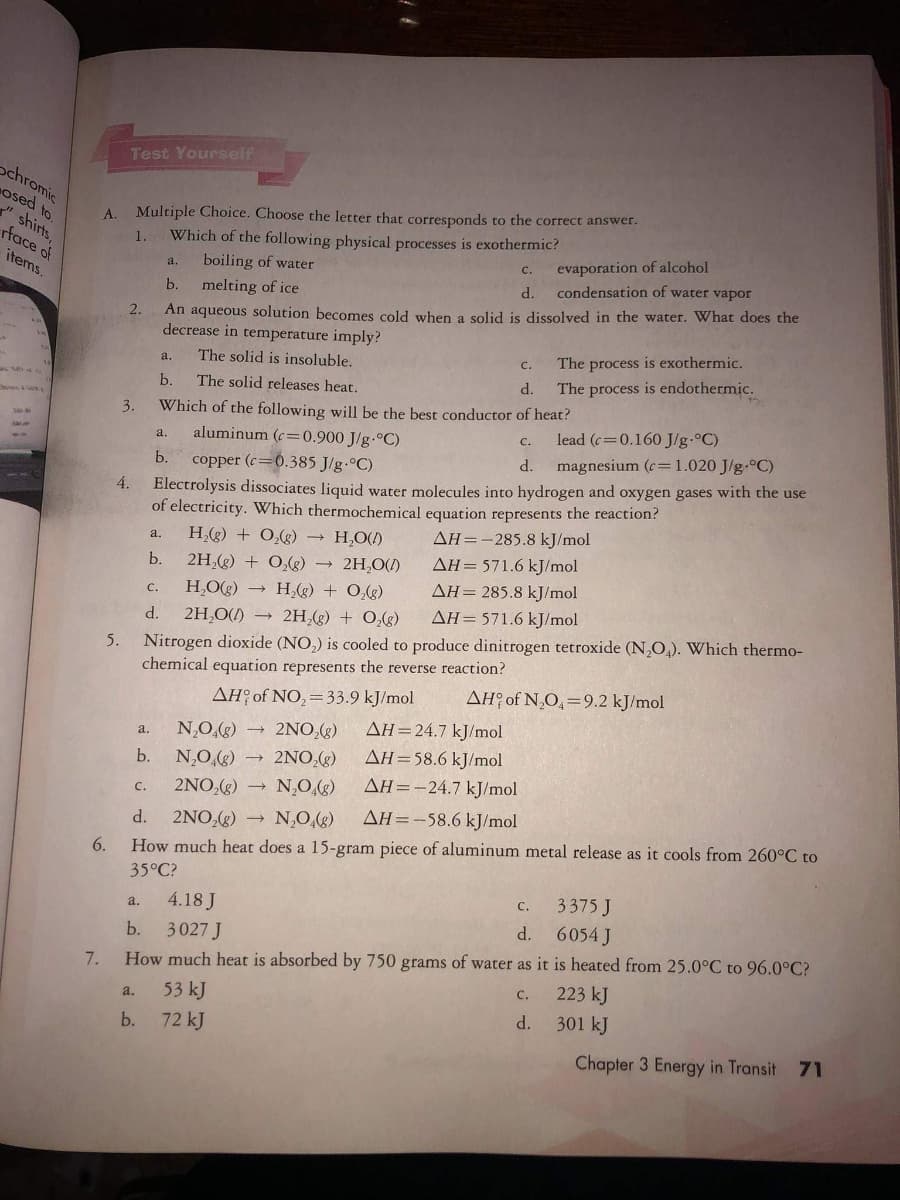A. Multiple Choice. Choose the letter that corresponds to the correct answer. Which of the following physical processes is exothermic? boiling of water 1. a. evaporation of alcohol condensation of water vapor C. b. melting of ice d. 2. An aqueous solution becomes cold when a solid is dissolved in the water. What does the decrease in temperature imply? a. The solid is insoluble. The process is exothermic. C. b. The solid releases heat. The process is endothermic. d. Which of the following will be the best conductor of heat? aluminum (c=0.900 J/g.°C) a. с. lead (c 0.160 J/g.°C) b. copper (c=0.385 J/g.°C) d. magnesium (c= 1.020 J/g-°C) 3.
A. Multiple Choice. Choose the letter that corresponds to the correct answer. Which of the following physical processes is exothermic? boiling of water 1. a. evaporation of alcohol condensation of water vapor C. b. melting of ice d. 2. An aqueous solution becomes cold when a solid is dissolved in the water. What does the decrease in temperature imply? a. The solid is insoluble. The process is exothermic. C. b. The solid releases heat. The process is endothermic. d. Which of the following will be the best conductor of heat? aluminum (c=0.900 J/g.°C) a. с. lead (c 0.160 J/g.°C) b. copper (c=0.385 J/g.°C) d. magnesium (c= 1.020 J/g-°C) 3.
Chemistry: Matter and Change
1st Edition
ISBN:9780078746376
Author:Dinah Zike, Laurel Dingrando, Nicholas Hainen, Cheryl Wistrom
Publisher:Dinah Zike, Laurel Dingrando, Nicholas Hainen, Cheryl Wistrom
Chapter12: States Of Matter
Section: Chapter Questions
Problem 96A
Related questions
Question
1 2 3

Transcribed Image Text:Test Yourself
ochromic
osed to.
Multiple Choice. Choose the letter that corresponds to the correct answer.
Which of the following physical processes is exothermic?
boiling of water
A.
" shirts,
rface of
1.
evaporation of alcohol
condensation of water vapor
items.
C.
a.
d.
b.
melting of ice
An aqueous solution becomes cold when a solid is dissolved in the water. What does the
decrease in temperature imply?
2.
The solid is insoluble.
The process is exothermic.
с.
a.
d.
The process is endothermic.
b.
The solid releases heat.
Which of the following will be the best conductor of heat?
aluminum (c=0.900 J/g.°C)
3.
lead (c=0.160 J/g.°C)
C.
a,
d.
magnesium (c=1.020 J/g-°C)
copper (c=0.385 J/g.°C)
Electrolysis dissociates liquid water molecules into hydrogen and oxygen gases with the use
of electricity. Which thermochemical equation represents the reaction?
H(g) + 0,(g) H,O()
b.
4.
AH=-285.8 kJ/mol
a.
AH= 571.6 kJ/mol
AH= 285.8 kJ/mol
AH=571.6 kJ/mol
b.
2H,(g) + 0,(g) 2H,0()
H,Og) →
H(g) + 0,(g)
с.
d.
2H,O() → 2H,(g) + 0,(g)
Nitrogen dioxide (NO,) is cooled to produce dinitrogen tetroxide (N,O,). Which thermo-
chemical equation represents the reverse reaction?
5.
AH? of NO,=33.9 kJ/mol
AH? of N,O,=9.2 kJ/mol
N,O.(g)
- 2NO,(3)
AH=24.7 kJ/mol
a.
AH=58,6 kJ/mol
AH=-24.7 kJ/mol
b.
N,0,(g)
→ 2NO,(g)
2NO,(g)
N,O,()
с.
d.
2NO,(g) → N,O,(g)
AH=-58,6 kJ/mol
6.
How much heat does a 15-gram piece of aluminum metal release as it cools from 260°C to
35°C?
4.18 J
с.
3375 J
a.
3027 J
d. 6054 J
b.
7.
How much heat is absorbed by 750 grams of water as it is heated from 25.0°C to 96.0°C?
223 kJ
с.
53 kJ
a.
d. 301 kJ
b. 72 kJ
Chapter 3 Energy in Transit 71
Expert Solution
This question has been solved!
Explore an expertly crafted, step-by-step solution for a thorough understanding of key concepts.
This is a popular solution!
Trending now
This is a popular solution!
Step by step
Solved in 2 steps with 1 images

Knowledge Booster
Learn more about
Need a deep-dive on the concept behind this application? Look no further. Learn more about this topic, chemistry and related others by exploring similar questions and additional content below.Recommended textbooks for you

Chemistry: Matter and Change
Chemistry
ISBN:
9780078746376
Author:
Dinah Zike, Laurel Dingrando, Nicholas Hainen, Cheryl Wistrom
Publisher:
Glencoe/McGraw-Hill School Pub Co

Chemistry
Chemistry
ISBN:
9781305957404
Author:
Steven S. Zumdahl, Susan A. Zumdahl, Donald J. DeCoste
Publisher:
Cengage Learning

Chemistry: An Atoms First Approach
Chemistry
ISBN:
9781305079243
Author:
Steven S. Zumdahl, Susan A. Zumdahl
Publisher:
Cengage Learning

Chemistry: Matter and Change
Chemistry
ISBN:
9780078746376
Author:
Dinah Zike, Laurel Dingrando, Nicholas Hainen, Cheryl Wistrom
Publisher:
Glencoe/McGraw-Hill School Pub Co

Chemistry
Chemistry
ISBN:
9781305957404
Author:
Steven S. Zumdahl, Susan A. Zumdahl, Donald J. DeCoste
Publisher:
Cengage Learning

Chemistry: An Atoms First Approach
Chemistry
ISBN:
9781305079243
Author:
Steven S. Zumdahl, Susan A. Zumdahl
Publisher:
Cengage Learning



World of Chemistry, 3rd edition
Chemistry
ISBN:
9781133109655
Author:
Steven S. Zumdahl, Susan L. Zumdahl, Donald J. DeCoste
Publisher:
Brooks / Cole / Cengage Learning